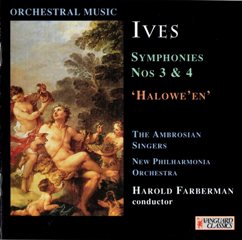Ives - Symphonies Nos. 3 & 4
Ives - Symphonies Nos. 3 & 4

01. Symphony No. 3 - Andante Maestoso [0:08:44.45] 02. Symphony No. 3 - Allegro [0:07:13.10] 03. Symphony No. 3 - Largo [0:07:24.32] 04. Symphony No. 4 - Prelude [0:03:18.70] 05. Symphony No. 4 - Allegretto [0:13:08.35] 06. Symphony No. 4 - Fugue [0:09:21.68] 07. Symphony No. 4 - Largo [0:09:28.00] 08. Three Outdoor Scenes - Hallowe'en [0:03:13.40] New Philharmonia Orchestra Harold Farberman – conductor
The Symphony No. 3, S. 3 (K. 1A3), The Camp Meeting by Charles Ives (1874–1954) was written between the years of 1908 and 1910. In 1947, Ives was awarded the Pulitzer Prize for Music for his Symphony No. 3. Later, his works were performed by conductors like Leonard Bernstein. Ives is reported to have given half the money to Lou Harrison, who conducted the premiere. The symphony has many influences including War songs, dances, and general European classical music. It evokes country meetings during his childhood, when people gathered in fields to sing, preach, and listen. Ives was sentimentally nostalgic, glancing back as a modern composer at a nineteenth-century childhood of hymns, bells, and children's games throughout the three movements. The symphony is filled with complex harmonies and meters.
The Symphony No. 4, S. 4 (K. 1A4) by Charles Ives (1874–1954) was written between the years of 1910 and 1916. The symphony is notable for its multi-layered complexity - usually necessitating two conductors in performance - and for its over-sized orchestra. Combining elements and techniques of Ives's previous compositional work, this has been called "one of his most definitive works"; Ives' biographer, Jan Swafford, has called it "Ives's climactic masterpiece." The program of the work echoes that of The Unanswered Question— Ives said the piece was "a searching question of 'What' and 'Why' which the spirit of man asks of life". Use of quotation is again rife, especially in the first movement, and there is no shortage of novel effects. In the second movement, for example, a tremolando is heard throughout the entire orchestra. In the final movement, there is a sort of musical fight between discordant sounds and more traditional tonal music. Eventually a wordless chorus enters, the mood becomes calmer, and the piece ends quietly with just the percussion playing. The symphony did not have a complete performance until Leopold Stokowski conducted it with the American Symphony Orchestra at Carnegie Hall on April 26, 1965, almost 50 years after the completion of the work, and 11 years after Ives' death.
Last Updated (Thursday, 15 March 2012 10:14)








